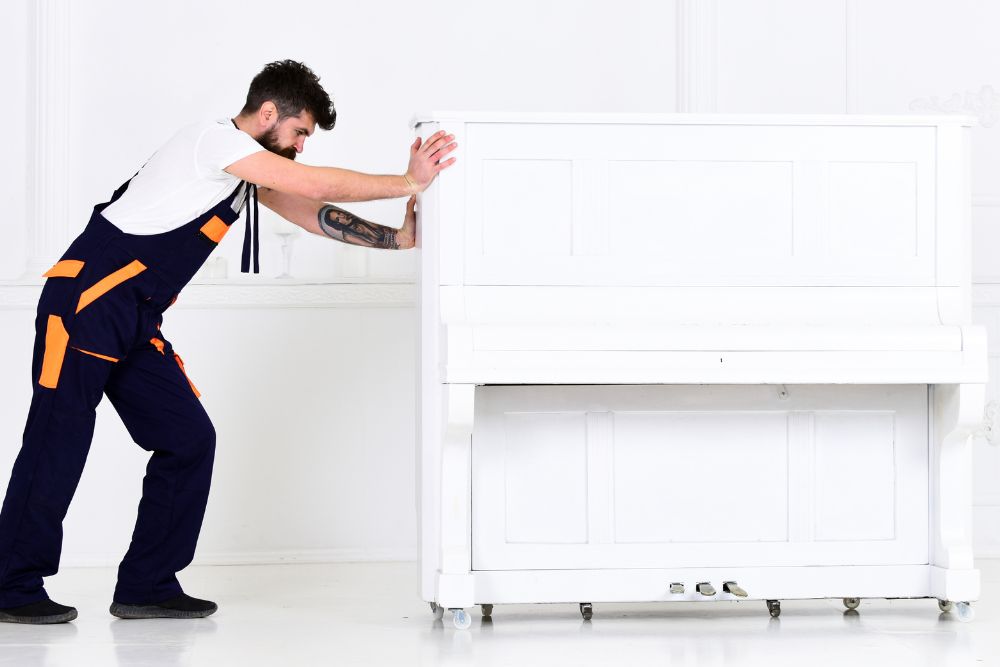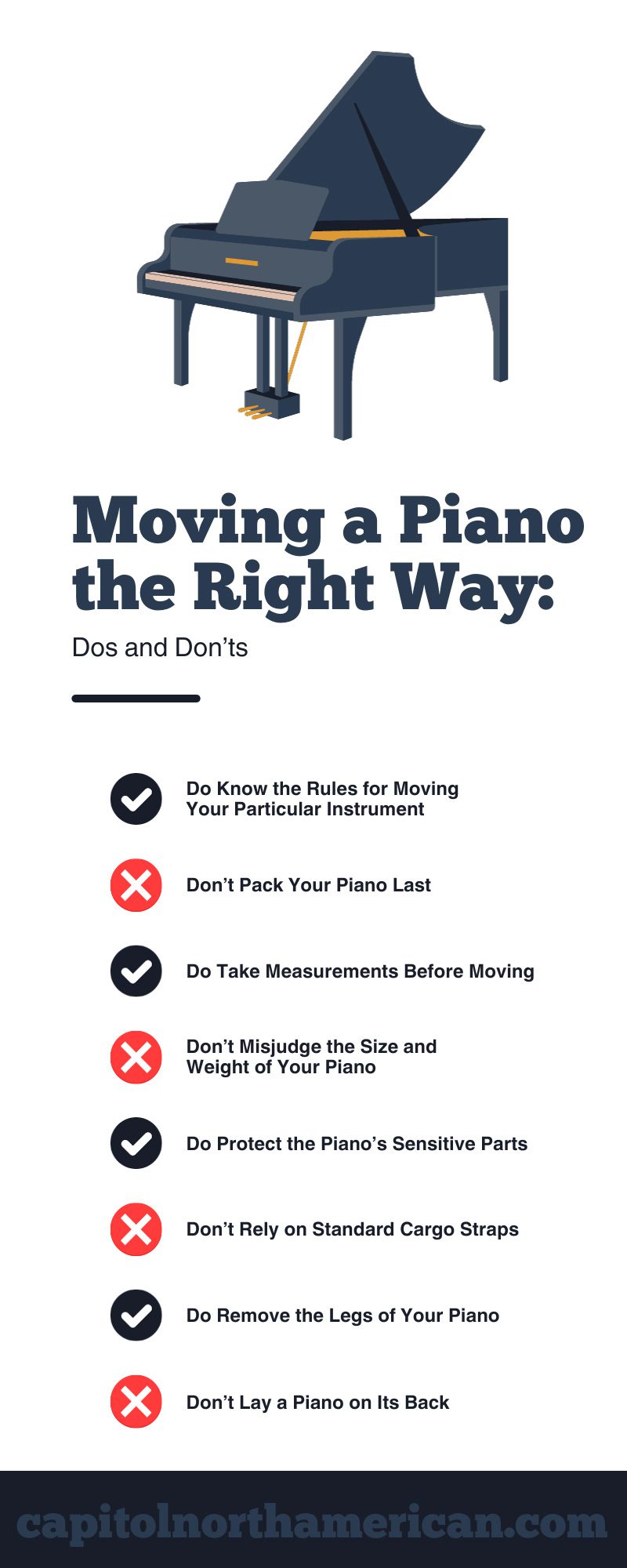
Moving a musical instrument, especially one as grand and delicate as a piano, requires special care. Knowing the intricacies involved can make all the difference when it comes to keeping your piano safe and ensuring its longevity. In this guide, we will show you how to move a piano the right way with our helpful list of dos and don’ts. Following these suggestions will help you enjoy a hassle-free move and allow you to enjoy the warmth and music your piano brings into your home.
The Dos
Do Know the Rules for Moving Your Particular Instrument
Each piano, whether a grand, upright, or spinet, has unique specifications and requirements when moving. Read the manufacturer’s guidelines and consult the user manual for your instrument. You can also consult with professional piano movers to better understand the essential details. Understanding these details will help you achieve a safer move and reduce the risk of damage.
Do Remember To Pack Your Piano Properly
Secure the keyboard lid to ensure it does not open during the move. Wrap thick padding or blankets around the body to prevent scratches. Make sure to secure the padding, but avoid directly attaching adhesives such as tape to the piano’s surface, as these may leave a residue.
Do Know Where You Want To Place Your Piano
Before the move, decide on the spot where your piano will reside. Pianos are sensitive to temperature and humidity. The ideal location will be away from direct sunlight, radiators, or any other heat. Avoid spots near windows or exterior walls that might expose the instrument to moisture or drastic temperature changes.
Do Take Measurements Before Moving
Measure your piano’s dimensions and the dimensions of doorways, hallways, and the final room it will reside in. These measurements will help you achieve a smooth transition without unexpected obstacles. You never want to discover that your piano will not fit through your main hallway or bedroom door. Attempting to fit a piano through a small space can have disastrous consequences, from piano damage to human injuries.
Do Remove the Legs of Your Piano
Removing the legs makes pianos—especially grand pianos—easier to move and less prone to breakage. Once you remove the legs, place the piano on a skid board for added protection and ease of movement.
Do Protect the Piano’s Sensitive Parts
Beyond the keys, there are numerous sensitive parts on a piano, including the pedals and strings. Use cushioning or protective layers to shield these areas, protecting them from undue harm during the move.
The Don’ts
Don’t Pack Your Piano Last
Prioritize moving your piano at the beginning of your move. By ensuring its safe placement inside the moving truck, you eliminate the chance of other items squeezing or damaging it. Moreover, packing it first guarantees ample space and avoids potential mishaps and challenges.
Don’t Misjudge the Size and Weight of Your Piano
Pianos are not just bulky; they are extremely heavy objects. Misjudging its weight can lead to serious injuries and force you to make several moving trips. Always have enough hands on deck and employ the proper lifting techniques to protect the movers and the instrument.
Don’t Forget To Ask Your Friends for Help
The task of moving a piano is not for the faint-hearted. Rally your friends or neighbors to assist. More hands make the work lighter and the process smoother. Remember, it’s not just about muscle; it’s about coordination.
Don’t Rely on Standard Cargo Straps
While they might be handy for other household items, standard cargo straps may not provide the needed support for a piano. Use heavy-duty straps designed for moving large objects. Doing so will help the instrument stay in place and shield it from potential damage.
Don’t Assume That All Pianos Are the Same
Just as each musician has their unique flair, each piano is distinct. Factors such as size, weight, age, and design play a role in how you should handle each instrument. Always approach each piano move with fresh eyes and a tailored plan.
Don’t Lay a Piano on Its Back
Upright pianos should always remain upright. Laying them on their back can harm their internal mechanisms. When moving these instruments, always keep them in their natural upright position.
Don’t Forget To Lock the Piano Lid
An oversight as simple as forgetting to lock the piano lid can lead to significant damage and surprises during the moving process. Locking the lid ensures dust, external pressure, and other unforeseen elements cannot harm the piano keys.
Reasons To Hire Professional Piano Movers
Despite knowing the detailed dos and don’ts, one cannot overlook the advantages of hiring professionals. Hiring local relocation services that specialize in moving pianos can save you both time and potential repair costs. These professionals have the right tools, experience, and expertise to ensure your piano’s safe transition to its new home. They understand the nuances of moving a piano and have faced numerous moving scenarios, making them adept at handling challenges on the go.
Moreover, pianos are not just heavy; they’re intricate instruments with thousands of moving parts. One wrong move could result in costly damage or, worse yet, render it unplayable. Professional movers understand how to handle the complexities of pianos and protect every component.
These experts know the best practices for packaging, lifting, and transporting precious items like pianos. Movers’ specialized vehicles will minimize jostling to limit the chance of an accident. They also use special padding and securing techniques that the average person may not have the tools or knowledge to take advantage of. These techniques help minimize the risks of scratches, dents, or internal damage during transit.
Furthermore, you cannot overstate the peace of mind you get by trusting experts. It helps alleviate the stress of the move, allowing you to focus on other essential tasks. You’re not just hiring a moving service; you’re investing in the preservation of your instrument. By entrusting its care to those who do this work every day, you ensure the instrument’s longevity and safeguard its value. Hiring a professional piano mover is a prudent choice for any piano owner who wants the best for their cherished instrument.
Local Moving Services in Las Vegas, NV
Your piano is more than just an instrument; it’s an investment, a cherished item, and a family heirloom. Treat it with the love, respect, and care it deserves by following our dos and don’ts for moving a piano the right way. Following our advice will ensure your piano’s melodies continue to warm your home for years to come.
For local moving services in Las Vegas, NV, look no further than Capitol North American. Our team has decades of combined experience transporting sensitive and heavy equipment for movers throughout the city. We will take great care of your piano and provide the best and safest handling throughout the moving process.


